Sheet metal refers to the flat pieces of metals with varying thicknesses created by the rolling process and comes in a rectangular shape. A range of sheet metals like aluminum, steel, copper, brass, and titanium is Convertible into usable parts and products using the sheet metal fabrication approach.
Sheet metal fabrication is the process of converting sheet metal into a desirable shape. It involves various manufacturing steps, such as cutting, bending, stamping, welding, punching, joining, finishing, and many more.
This article will briefly discuss the steps and applications involved in sheet metal fabrication.
Major Steps in Sheet Metal Fabrication
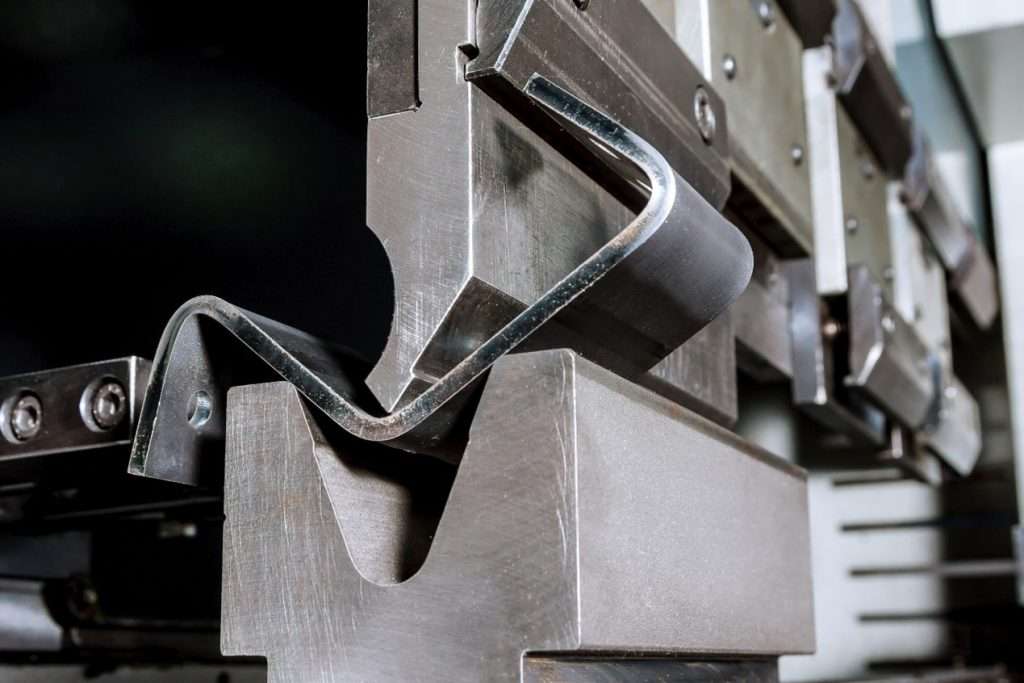
Sheet Metal Bending
Step 1: Development of a 3D model or 2D drawing
Creating a 3D model or 2D drawing is the first step in sheet metal fabrication. Design software such as AutoCAD, Solidworks, and Creo are used to prepare detailed 3D designs. The design work as a blueprint in sheet metal fabrication. It includes all the necessary tolerances, features, and dimensions for fabricating the item.
Step 2: Machine code/ Digital instruction
The machining procedure is finalized using the created 3D model. It involves the programming process ( G-code), which dictates the machines for various machining sequences. Digital instructions are provided to the machine based on the required operations.
Step 3: Precise machining
Once the machining sequence and the creation of digital instruction get compted, the operator starts the machining process. Generally, the machining process begins with cutting sheet metal and is followed by other operations such as bending, drilling, stamping, and joining.
Techniques of Sheet Metal Fabrication
There are different techniques used in sheet metal fabrication. It starts with the cutting of big rectangular sheet metal into small pieces. Let’s overview some of the methods in detail.
1. Cutting process
Cutting of sheet metal is the primary stage in sheet metal fabrication. It involves the cutting of standard-size rectangular sheets into the desired size. There are various ways to cut sheet metal, such as sheet metal shearing, blanking, punching, water-jet, and laser cutting. However, the use of CNC technology for cutting operations is more accurate and precise.
There are two distinct methods for cutting sheet metal: shear and non-shear.
1.1 Shear-cutting
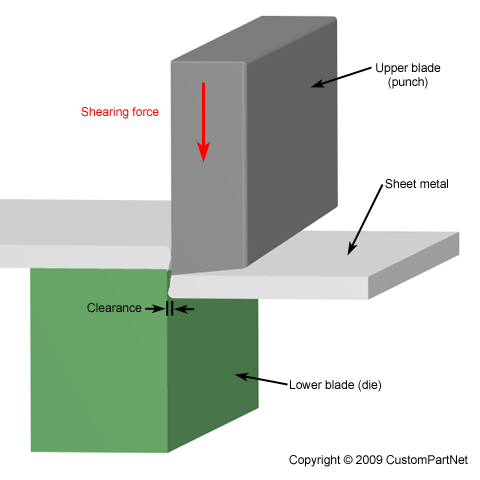
Shear-cutting process
As the name implies, shear-cutting techniques split the sheet metal into two pieces by exerting shear force beyond the material’s maximum shear strength. Following are some popular and effective shear-cutting techniques used in sheet metal fabrication.
Shearing
Shearing is an effective approach for soft metals with no requirement for a high-quality sheet metal surface finish. It cuts the sheet metals straight by applying the shear force on the surface. It is a quick, low-cost process that produces straight edges on the cutting surface.
Sawing
Sawing is the cutting of sheet metal using a saw tooth tool. The shear force of the saw-tooth and friction between the tooth and sheet surface tear apart the material. It is applicable for brass, aluminum, and various non-ferrous sheets. Saws come in both horizontal and vertical varieties. Vertical is suited for intricate cuts, whereas horizontal is used for lengthy& straightforward cuts.
Punching
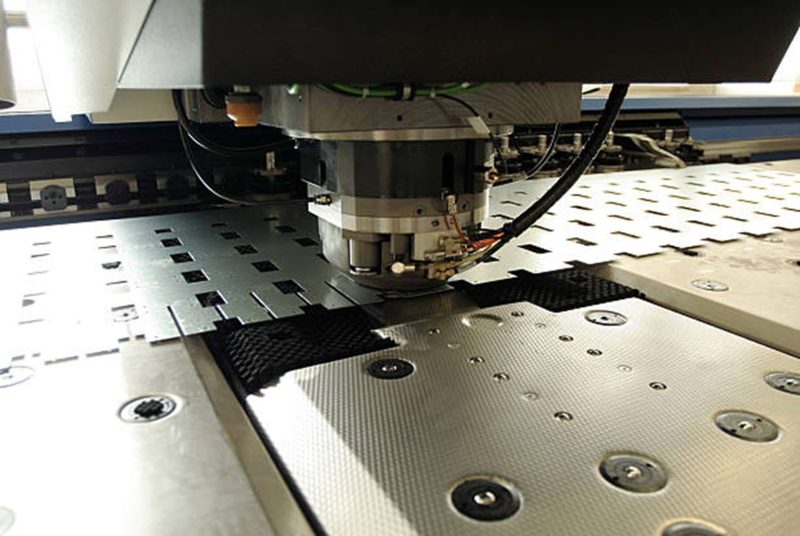
Sheet metal punching operation
Punching is the shear-cutting technique in which holes are made by applying the shear force. Punching die is a necessary component in the process. The punching machine punches the sheet placed in the die and crates the various shapes of holes. It is a delicate and time-consuming operation that calls for precise punching and match dies.
Blanking
The blanking process removes the material from sheet metal. The material taken out will be scrap, while the remaining sheet will be a required part. The blanking die holds the sheet, which gets punched to remove the specific portion of the sheet. It is an economical process that creates various custom parts with high repeatability and dimensional consistency.
1.2 Cutting without shear (non-shear)
Non-shear cutting techniques use intense heat, pressure, or abrasive blasting on the cutting position instead of shear force to split the sheet metal. Following are the non-shear cutting techniques used in sheet metal fabrication.
Laser cutting
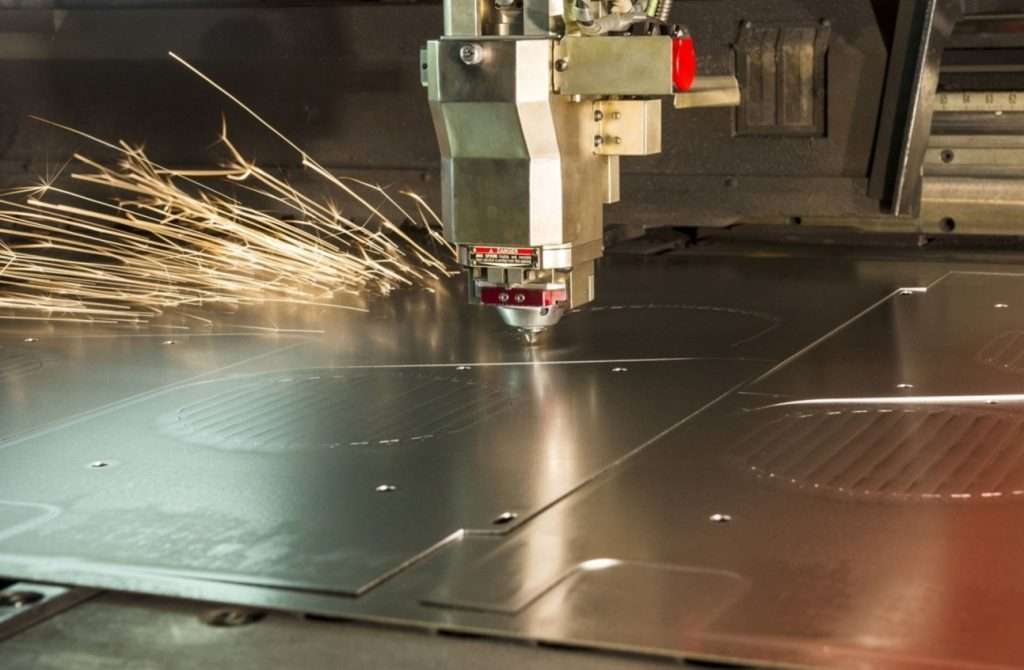
Laser cutting
Using a highly concentrated laser beam, laser cutting techniques create precise cuts in sheet metal. When the beam strikes the designated spot, it splits the workpiece with the help of Intense Heat by melting and vaporizing after absorbing the thermal energy. Laser cutting can cut materials with a thickness of up to 10 mm.
Water-jet cutting
Water jet cutting involves striking water with high pressure and speed (60,000 psi & 610m/s) on the cutting position to split the sheet metal. Water might contain abrasive elements, such as sand, glass pieces, grains of high-carbon steels, and others. However, pure water is also used to cut the sheets of soft materials.
Both soft and hard materials, including foam, plastic, steel, copper, brass, titanium, and aluminum, are appropriate.
Plasma cutting
Plasma cutting is also a thermal cutting process, which uses a beam of ionized gas (plasma) to split the sheet metal. It is a practical cutting approach for electrically conductive materials such as copper, brass, steel, etc. In the fabrication of sheet metal, plasma cutting delivers a high degree of accuracy and repeatability.
2. Forming Processes
The forming technique shapes the sheet metal into functional and desirable parts while maintaining the solid state throughout the process. Now, we will discuss various forming processes used in sheet metal fabrication.
Bending

Bending process
Sheet metal bending involves surface deformation at the bending position using force along an axis to create the desired shape. It has been used in manufacturing for many decades. However, the latest CNC bending technology bends sheet metal at the correct angle.
The bending process starts with clamping sheet metal into the die. Then, pressure is applied to achieve the desired curvature.
Stamping
Stamping presses and die are two important components of the stamping process. Sheet metal is placed into the die, and presses exert force on the metal sheet to shape it into the desired shape. Various complex shapes are achievable with the stamping process. The only basic requirement is designing of dying according to the required geometry.
It is compatible with many materials, including steel, aluminum, copper, and brass. The tight tolerance of dies is also necessary for the stamping process to be accurate and for each stamp to maintain the ideal component quality.
Curling
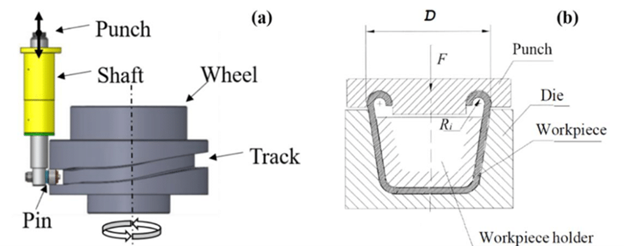
Curling process
The curling process involves joining hollow rolls on the edges of sheet metal, which eliminates the sharp edges. It requires curves for the curls and closing of it. Curling dies produce curves; the workpiece is curled as per the shape of the curling die.
Other forming processes are also used in sheet metal fabrication, such as sheet metal hemming, rolling, drawing, embossing, and flanging, based on the specific needs.
Try Prolean Now!
3. Joining Processes
The joining process involves fusing two or more sheet metal parts to form a single unit. It is applicable for creating and assembling the parts to form an intended shape. Depending on the techniques used, the joints could be permanent or temporary.
There are various techniques of sheet metal joining, including Welding, Riveting, Brazing, Soldering, Brazing Bonding, Screwing, and many more.
Riveting
Riveting creates semi-permanent joints to join two or more sheet metal pieces. It is useful for both part customization and part assembly.
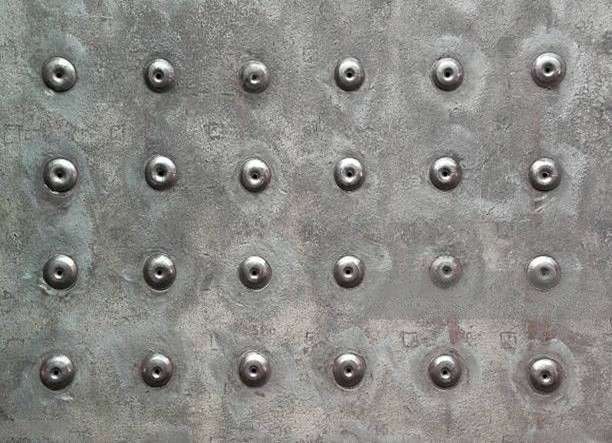
Riveting on sheet metal
The process involves creating a series of multiple overlapping holes and inserting Small metal pins in those holes to bond the metal pieces. The tail portion (which goes on the hole) is stretched to the end and hammered to prevent removal.
Welding
Welding is another joining process with the application of heat, pressure, or both. However, mostly involves the heat and melting of sheet metals at the joining position to create permanent joints after cooling.
Welding requires welding rods or gases to target joining positions, which melt the designated area. Many welding techniques include TIG, MIG, stick, plasma arc, and laser beam. In addition, filler material is also used in some welding types.
Brazing
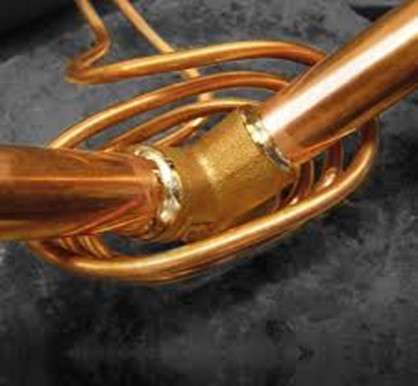
Brazing joint
Brazing techniques join the surface sheet metals by flowing the molten metal into the joining position. The process consists of the filler material having a melting temperature less than parent materials. Sheet metals are only eligible for brazing joints if they are metallurgically compatible.
Applications
For many industries, sheet metal fabrication is the go-to method for producing parts and products. It applies to construction to the aerospace industry.
| Applications | Description |
|
Enclosures & Housing |
Sheet metal fabrication technology can create very tiny enclosures to medium & large cabinets. For example, gearboxes and machinery housing. |
|
Automotive |
It is a versatile approach to creating various automobiles, including doors, roofs, chassis, hooding, and many more. |
| Electrical | Enclosure for various electrical & electronic appliances, shielding, and other parts. |
| Aerospace | Helicopter parts, floor panels, AC systems, Bezels, seats, and many more. |
| Construction | Construction frequently uses metal fabrication, including drains, air ducts, frames, flange channels, and support structures. |
| Shipbuilding | Flooring panels, ladders, interior, furniture, and many more. |
| Medical | Customize patient beds, surgical, physical therapy, HVAC, and more. |
Conclusion
Sheet metal fabrication is one of the most versatile approaches in the manufacturing industry. It involves various steps, such as cutting, forming, joining, and finishing, and various techniques to create customized parts and products. In addition, every step has several alternatives for accomplishing it.
It is a complex process due to the different processes and alternate techniques. However, choosing the right type of process helps optimize the fabrication’s functionality and cost. Prolean’s Sheet metal fabrication service makes it easy for you. Based on your specifications, we choose your project’s optimal course of action and deliver the parts to your door.
FAQ’s
What is meant by sheet metal fabrication?
Sheet metal fabrication is the process of converting a metal sheet into the desired shape. It involves multiple stages throughout the process, such as cutting, bending, welding, surface treatment, and many more.
What distinguishes shear cutting from non-shear cutting?
Shear-cutting techniques use the shear force to split the sheet by overcoming the material’s maximum shear strength. As opposed to non-shear methods, which employ pressure, heat, or abrasive blasting.
What is the popular sheet metal forming processes?
The most common forming techniques in sheet metal fabrication are bending, stamping, curling, hemming, rolling, drawing, and embossing.
What is the range of workable thickness in sheet metal fabrication?
It can work on sheet metal with a thickness range of 0.5 to 5 mm.




0 Comments